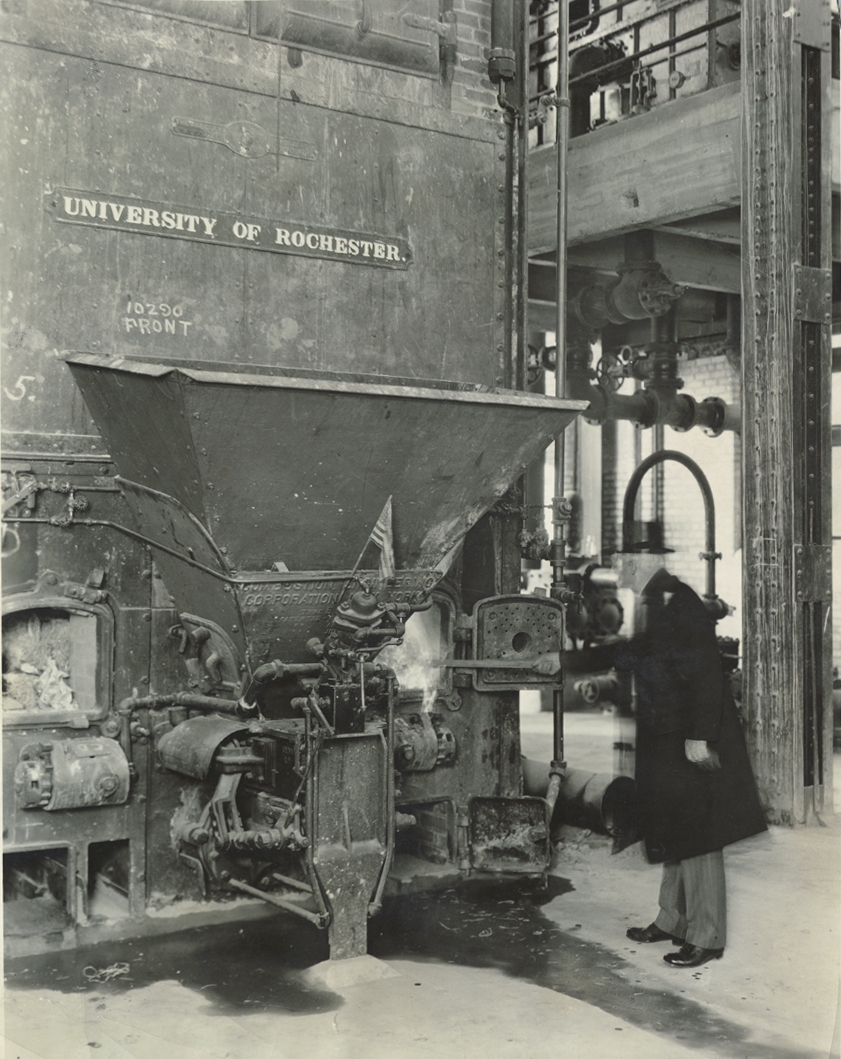
(Rush Rhees Library Rare Books, Special Collection and Preservation)
| Central Utilities |
 |
| University of Rochester President Rush Rhees lighting the first
boiler in the Central Utility Plant, November 10, 1924. (Rush Rhees Library Rare Books, Special Collection and Preservation) |
The University of Rochester built a new heating plant to supply steam to a new hospital and medical school constructed along Elmwood Avenue in the 1920s. The plant has been greatly expanded over the years to serve the growing University.
Electricity
In planning for the new Medical Center and River Campus, it was decided
that it would make its own steam and buy electricity from RG&E. The
heating plant was located next to Rochester Gas & Electric Corporation
(RG&E) substation 33, which had been built in 1907 to
interconnect with the new transmission lines of the Niagara, Lockport and
Ontario Power Company from Niagara Falls. This new substation
provided 11,000 Volt power for the electrification of the Erie Railway and
and 4,160 Volt power to the Medical Center and River Campus. An
AC/DC converter was also installed in the heating plant to supply DC
current to equipment in the Medical Center.
This experience likely led to the University connecting all of its buildings on the Prince Street Campus into a single electric meter in 1927, greatly reducing electric costs for that campus
The 1966 Nuclear Structure Research Laboratory on South Campus was supplied from a 34,500 Volt circuit from Station 33, which also served the 1977 Laboratory for Laser Energetics through a 34.5/11.5kV transformer.
Around 1967 the University started buying power from RG&E at the lower cost 11,500 Volt rate to supply the new Science and Engineering buildings on River Campus. A large new substation was also built in 1969 next to the Supplies and Accounts building in the Medical Center to support the new S-Wing and Strong Memorial Hospital. This substation also included two new transformers that supplied the existing 4,160 Volt network. In 1989, the University's energy manager recommended installation of two new transformers at the Central Utilities Plan to supply the older River Campus buildings, allowing abandonment of the higher cost RG&E 4,160 Volt service.
RG&E advised the University around 2005 that it had reached the limit of available 11,500 Volt power from Station 33. Plans to build a new Mid-Campus chiller plant and Clinical Translational Sciences Building were modified to include construction of a new 34,500/11,500 Volt substation in a brick enclosure south of the chiller plant that tapped into the same circuit serving the South Campus buildings. This station also supplied the new Golisano Children's Hospital.
Planning to meet the future electric needs of the growing campus resulted in a plan to built a new 115,000 Volt substation (now known as 710) on South Campus adjacent to the RG&E transmission lines. This station opened in 2015 and initially replaced the 34.5 kV Mid-Campus Substation. In April 2021 the Central Utilities Plant electric system was connected to this substation, eliminating that facility's connections to Station 33. This new system provides power to all contiguous buildings except the Alumni and Advancement Center, Graduate Living Center, Ronald McDonald House, Child Care Center, Goler House, Eastman Dental, and 612 Wilson Boulevard. Connecting these buildings would reduce their RG&E connection charges, but each would require analysis of the connection cost and savings to see if this was economical.
The University entered into several contracts with RG&E in the 1990s to duplicate the savings that would have accrued from a proposed cogeneration unit at the Central Utilities Plant. The University became a direct customer of the New York Independent System operator in 2001, giving it the ability to buy power directly from the grid. After the final RG&E contract expired in 2003, the University's energy manager recommended entering into a two-year Contract for Differences (CfD) with a regional merchant power plant to stabilize its electric costs. This arrangement saved the University $5,379,730 over a 24-month period.
Heating
Steam was provided by coal-fired boilers until 1972, when #6 oil firing
was added. In 1997 when the plant boilers were converted to natural
gas. A low-temperature hot water distribution system was built as part of
the 2005 cogeneration project. The following table shows the boilers
that have been installed in the plant since 1924, based on available
information. B&W = Babcock & Wilcox | CE = Combustion
Engineering | Boiler 3 was originally a coal stoker that was converted to
only burn #6 oil in the 1970s | Boilers 3, 5, 6 and 7 were converted to
burn natural gas & #2 oil in 1997.
A fabric baghouse designed by Sherburne Engineering was built on the roof of the new boiler house in 1983 to capture particulate matter to reduce visible pollution, but it never worked and was removed in 1997. The baghouse was so heavy that it buckled the brick wall on the south side of the plant, which had to be reinforced with metal plates which can still be seen.
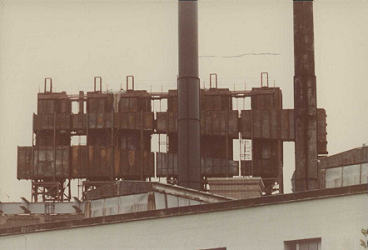 |
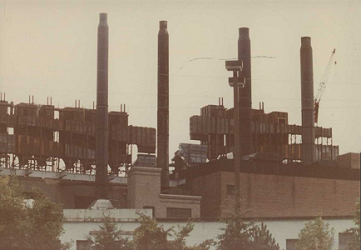 |
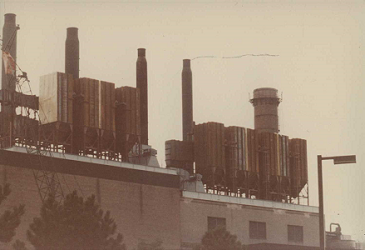 |
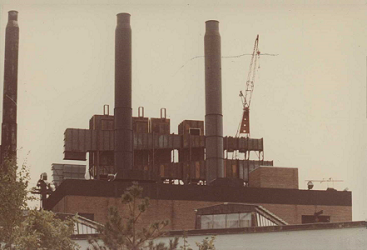 |
| Year | # | Mfr. | Fuel | Cap. | Notes |
| 1924 | B&W | Coal | 200 HP | Removed 1948 |
|
| 1924 | (#1) |
B&W | Coal | 400 HP | Removed 1957 |
| 1924 | (#2) |
B&W | Coal | 400 HP | Removed 1957 |
| 1928 | (#3) |
B&W | Coal | 456 HP |
Removed 1961, sold to Mexico |
| 1928 | (#4) |
B&W | Coal | 456 HP |
Removed 1961, sold to Mexico |
| 1948 | (#5) | CE | Coal | 60K pph | Replaced by Boiler #5 in 1972 |
| 1957 | #3 | B&W | Coal; #6 oil* | 100K pph | Replaced by Boiler #10 in 2016 |
| 1961 | #1 | B&W | Coal | 100K pph | Abandoned in place mid-1990s, removed 2004 |
| 1967 | #6 | B&W | Coal; #6 oil* | 150K pph | |
| 1972 | #5 | B&W | #6 oil* | 100K pph | |
| 1972 | #7 | B&W | Coal: #6 oil* | 150K pph | |
| 2005 | #9 | B&W | Nat Gas; #2 oil | 168K pph | |
| 2016 | #10 | Rentech | Nat gas; #2 oil | 120K pph |
Cogeneration
Several studies, starting in the early 1930s, have recommended the
adoption of combined heat and power, or cogeneration, to increase the
efficiency of the heating plant. These will be summarized here,
along with a description of the 2005 cogeneration project that was
adopted.
A 1995 attempt to implement steam turbine cogeneration was stymied because the director of Central Utilities (who had been manager of the Kodak Park Power Plants) did not understand the thermodynamics of cogeneration.
After the cogeneration plant came on line in 2005, several opportunities have been missed to to increase the plant's efficiency at little or no cost by reducing the hot water system return temperature. This is turn would have reduced the peak hot water sendout temperature.
The 2005 plant included three 750-kW Generac diesel generators to provide a black start capability. The Generac units were replaced in October 2023 with three new Caterpillar 1.5 mW units that should prove more reliable and provide greater capacity. The new blackstart units were installed on 28 November 2023 as shown below:
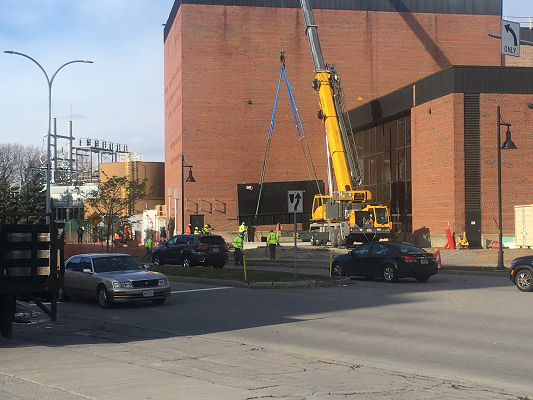 |
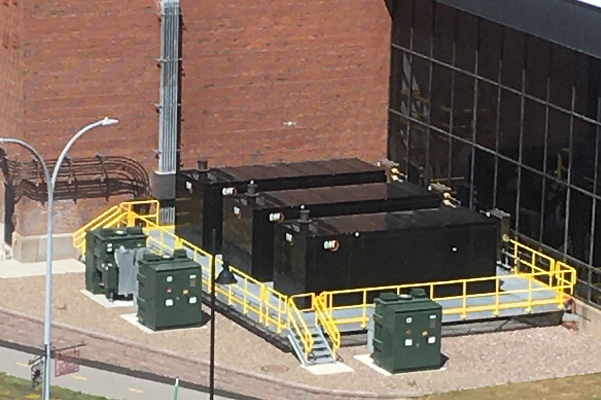 |
| Installation of New Blackstart
Generators |
New Blackstart Generators |
Air Conditioning
The first air conditioning at the University was a 164-ton Carrier
electric centrifugal chiller installed in the Eastman Theatre in
1929. Air conditioning on the River Campus was first produced by a
Carrier single-effect absorption chiller installed in 1963 in the
Administration building. This chiller also served the new Hopeman
Hall and also served the Interfaith Chapel. A similar unit in the
penthouse of the 1962 Bausch & Lomb Hall addition also supplied
chilled water to Hoyt Auditorium. Steam-driven centrifugal chillers
were installed in the expanded addition starting in 1967 to supply new
buildings and replace smaller chillers in the Medical Center and River
Campus. Chiller #5 was added in 1999 in the remaining chiller plant
bay. Carrier announced they would not make any more large chillers
on the same day the bid documents were released. There was not
enough river water to operate this unit so a temporary
cooling tower was installed, which was replaced with a permanent
modular tower the following winter. The plant can also provide "free
cooling" in the winter by using cold river water to produce chilled water
without mechanical compression.
Chilled water plant equipment data sheets from 2002.
Chiller #1 was removed in 2015 as it could not be converted to a non-CFC refrigerant. There are plans to convert the four remaining steam-turbine chillers to electric drives and to replace the existing river water pumphouse with a cooling tower. *Chillers #2, #3, and #4 have been converted from R-12 to R-134a. **Chillers #3 and #4 were re-rated up to 5,400 tons each after being refurbished.
A separate chiller plant with York electric centrifugal chillers was built on Mid-Campus in 2008 and expanded in 2013.
| Year | # | Mfr. |
Tons/hr | Refrigerant | Turbine HP | Elec KW | Condenser Water |
| 1967 | #1 | Carrier | 1,500 | R-11 | 1,400 | --- | Genesee River |
| 1969 |
#2 | Carrier | 4,500 | R-12* | 4,370 | 3,260 | Genesee River |
| 1971 |
#3 | Carrier | 4,500** | R-12* | 4,370 | 3,260 | Genesee River |
| 1972 |
#4 | Carrier | 4,500** | R-12* | 4,370 | 3,260 | Genesee River |
| 1999 | #5 | York | 6,300 | R-134a | 4,953 | 3,700 | Cooling Tower |
| 21,300 | 13,480 |
Water
The University buys water from the City of Rochester and Monroe County
Water Authority.
Energy Conservation
The oil shocks of the 1970s hit the University's budget very hard and
several efforts were undertaken to reduce energy use. A Honeywell
Delta 2000 was installed in a small building adjacent to Dewey
Hall and a Powers System 570 was installed in the new Strong
Hospital when it opened in 1975.
References
1906 "Transmission
Line from Niagara Falls to Syracuse," by Orrin E. Dunlap, Western
Elecrrician 38(8):151-152 (February 24, 1906)
1906 Deed from Fred D.
Corey to the Rochester Railway and Light Company, December 4, 1916, book
748, page 465
Site for Station 33; Corey was an attorney for the Niagara, Lockport, and
Ontario Power Company.
1907 "Niagara
Power Not Coming Yet," Democrat and Chronicle, April 24,
1907, page 14.
Contract with Railway and Light Company not signed.
1907 "The Transmission Plant of the Niagara, Lockport and Ontario Power Company," by Ralph D. Mershon, Proceedings of the American Institute of Electrical Engineers 28(2):1367-1407 (June 26, 1907) | also here |
1907 "Niagara
Power to be Received," Democrat and Chronicle, July 17,
1907, page 9.
Rochester Railway and Light Company Erecting Sub-station at Junction of
Elmwood Ave. and Lehigh Valley Railroad
1907 "Electrification of the Rochester Division of the Erie Railroad," by W. N. Smith, Electric Railway Review 18(15):428-436 (October 12, 1907)
1909 "Water-Power
and Transformer Stations of the Rochester Railway & Light Company,"
Electric Railway Journal 33(8):328-330 (February 20, 1909)
Description of Station No. 33.
1924 "Ceremony
Attends Lighting of Medical School Fires," Democrat and
Chronicle, November 11, 1924, Page 27.
The power house is equipped with two 400 horse-power and one 200
horse-power water tube boilers.
1925 "Fuel Consumption Measured by Engineering Department," Campus, October 23, 1925, Page 7.
1926 "University
of Rochester Installs New Heating Plant," by J. W. Gavett, Jr., Power
64(6):192-194 (August 10, 1926)
The boilers consist of two units of 4,000 sq.ft. each and one of 2,000.
All are built for 200 lb. working pressure, so that turbo-generators can
be installed later if desired. At present steam is generated at 100 lb.
gage for heating and electrical energy is purchased.
1926 "University of Rochester installs new heating plant - Discussion," by A. L. Westcott, Power 64:565 (October 12, 1926)
1926 "Coal,"
The Campus, October 22, 1926, Page 2.
Coal for the heating plants of all branches of the University is now
delivered at a central storage place at the heating plant of the Medical
School on Elmwood avenue.
1928 Rochester
Gas & Electric News & Year Book, February, 1928
Page 8: Picture of Station 33 showing new transformers to step down
110,000 volts to 11,000 volts.
1928 "Gavett
Talks to Engineers Club," Campus, March 2, 1928, Page 4.
Development of the power house on the new campus. He said that two
new boilers and stokers have been ordered to help in heating the new
college buildings. At present, three boilers are heating the Medical
School and hospital.
1931 "Fiery
Arrows Will Point to City Airport," Democrat and Chronicle,
May 27, 1931, Page 17.
The chimney at the power plant of the University of Rochester near Elmwood
Avenue has been pained a brilliant chrome yellow, supposed to be one of
the most visible colors from the sky. Black squares painted on the
yellow will further distinguish it.
1933 A study of purchased power vs self-generated power at the Elmwood avenue plant of the University of Rochester, by Gerald P. Troy. Master of Science Thesis, University of Rochester.
1936 The
First Decade 1926-1936
Page 92: The First Decade in Brief (January 4, 1926 to December 1,
1935)
Medical Center uses per year approximately 5,500 tons of coal to supply:
over 100,000,000 pounds of steam; approximately 5,500,000 cubic feet of
gas; nearly 2,000,000 kilowatt hours of electricity; approximately
l0,000,000 cubic feet of water.
1938 The economic feasibility of the generation of electrical energy by the University of Rochester, by Robert V. Adair
1940 Train
Wreck Near UR Power Plant, January 21, 1940 | picture
#2 | Picture
#3 | Picture
#4 |
The mangled remains of a coal car and a passenger car following a head-on
train collision on the Lehigh Valley tracks near the power plant on the
University of Rochester River Campus. Mounds of coal lie on the
embankment following the head-on collision of a southbound coal train and
a northbound passenger unit on the Lehigh Valley tracks. 100 feet south of
River Boulevard near the University of Rochester River Campus power plant.
1945 "Fuel Shortage Strikes Campus," Campus, February 9, 1945, Page 3.
1946 "Coal Supplies
Short," The Campus, November 22, 1946, Page 4.
The University uses 90 tons of coal a day, 20 on Prince St., and 70 on the
River Campus
1951 "Writer
Tells About Tunnels, Power Plant, and Smokestack," by George
Weinhold, Campus Times, March 9, 1951, Page 3. | part
2 |
The power plant building houses five boilers.
1954 "C.A.A.
Pays: Landmark Lit," Campus (September 24, 1954), Page
2.
Three double-flashing lights now adorn the top of the 195 foot smokestack
at the University Heating Plant.
1956 "Well-Equipped
Heating Plant Illustrates Mechanical Running of River Campus," Campus
Times, March 6, 1956, Page 5.
16,000 tons of coal each year. Five boilers ranging from 450 to 700
h.p.
1957 "Try
Our 'Free' Air," Democrat and Chronicle, October 13, 1957, Page C1
City's vigilant smokewatchers keep it pure -- at a price.
At the University of Rochester and Stromberg-Carlson, new boilers, the
first of their kind to be installed In Rochester, are being brought into
use. They employ a "moving grate" principle for spreading the coal on the
fire. Brundage said one of the main sources of smoke trouble has been with
"spreader" type stokers.
1957 Planning
and Construction Period of the School and Hospitals 1921-1925.
bu George H. Whipple, M.D.| pdf |
Page 10: It also was decided to place the power plant between the
University's new River Campus and the Medical School and Hospital area,
where it could be serviced by the Lehigh Valley Railroad with considerable
advantage in the delivery of coal. After discussion and comparison of
prices, it was thought best to build this plant for coal fuel rather than
to purchase heat from the Rochester Gas and Electric Corporation. Without
doubt, that was a sound decision. It was decided to purchase electricity
from the utility corporation rather than to manufacture it.
1961 "U.S.
Offers Aid On UR Chimney," Democrat and Chronicle, June 8,
1961, Page 13.
FAA to pay half the cost of lowering the UR smoke stack 67 feet.
1961 "Stack
on Spot, UR Fights Soot War," Democrat and Chronicle,
September 15, 1961, Page 20
Brundage said university officials have already installed one new boiler
at a cost of between $100,000 and $200,000, and will have another in
operation soon. Each has a dust (or soot) collector, installed at
what Brundage said was "considerable expense and not required."
1961 "Purchasing Adopts
System to Improve Multi-Million Dollar Operation," University Record
1(6):4-5 (November 1961)
Purchasing works through a customs agent in ochester for processing
incoming overseas goods. Recently two old boilers that had been replaced
in the Heating plant were sold in Mexico and shipped on three railroad
flatcars.
1962 "UR
Smokestack Shortened," Democrat and Chronicle, June 5, 1962,
Page 16
The 196-foot stack has been cut down to 61 feet at an over-all cost of
$589,000.
William Summerhays Sons was awarded a $297,294 contract to cut down the
brick stack, install new stacks, boilers and fans. The University of
Rochester is being paid $350,000 plus $13,500 a year for 25 years. The
annual payments are for maintaining the fans which are needed to create
draft for the shorter stacks. The higher stack had provided natural
draft.
The University of Rochester received an additional $234,000 for the
airspace rights opened up when the stack was lowered.
The Federal Aviation Agency agree to pay half the overall cost or
$294,500, the county the balance. The lower stack is expected to
east the landing of jets in the northeast-southwest runway after 1964.
1962 "New
Constructions Flourish on River Campus Grounds," Campus Times,
September 25, 1962, Page 2.
Of much interest to the student automobile owner is the sidewalk just
completed from the River Campus to the Medical Center and Parking
Lot. Beginning behind the Cyclotron the paved path leads across the
railroad tracks and out to Elmwood Avenue. The path will be
lighted. The days of trekking through the mud in the pitch-black
railroad-track dark in December and snow are over.
1962 "Architect
Speaks at Cabinet," Campus Times, November 9, 1962, Page 1.
| Part
2 |
The bulldozers in front of the Administration Building are part of a
project to install a central air conditioning unit on campus.
1964 "Steam Heat," University
Record 4(2):4-5 (February 1964)
The Heating Plant has three huge boilers. Two are B and W Jet Injection
stoke operated, each capable of 100,000 pounds of steam per hour, while
the third is a 60,000 pound per hour Combustion Engineering Spreader
Stoker. However, the maximum steam power the University requires at this
time of the year is about 135,000 pounds per hour so not more than two
boilers are in operation at a time. During the summer months only about
30,000 pounds are required per hour.
1964 "'Mr. Heat",' George
Haas Completes 40-Year Career, University Record 4(11):3 (December
1964)
Highlighting his career was the construction of the steam, heating and
plumbing distribution systems in the Medical Center and River Campus and
the installation of five boilers from 1923 to 1928 producing 64,000 pounds
of steam pressure per hour. Other significant changes were the removal and
replacement of these from 1948 to 1960 with three boilers capable of
producing 260,000 pounds per hour and reducing the height of the Heating
Plant stacks by 65 feet.
1965 "SMH Mobilizes,
Averts Disaster," University Record. 5(10):6 (November 1965)
A month after Strong Memorial Hospital’s disaster drill (see center
spread), a real crisis suddenly struck. On Tuesday, Nov. 9, Rochester
along with the whole Northeast was plunged into blackness from a massive
electrical power failure. November 9, 1965 Northeast Blackout, 5:20
pm until 8:20 pm.
Among the first fearful thoughts that enter a person’s mind in such a
situation is, “What about the hospitals? What will they do?”
1966 "Chilled Water Plant
Being Built," University Record 4(9):1, 3 (October 1966)
A chilled water plant, which will allow eventual air-conditioning of many
of the buildings at the Medical Center and on the River Campus, will soon
be constructed next to the present University Heating Plant.
This is the reason for all the digging—and dust—currently to be seen just
east of the Lattimore Road-Elmwood Avenue intersection, west of the AEP
annex.
Two additions will be made to the Heating Plant—one for the chilled water
facility, the other to increase the capacity of the present steam heating
facilities and electrical distribution center there.
“This is all being done to insure continuity of utilities to the River
Campus and Medical Center as they expand,” said chief electrician Fred
Curtis. “Without the new facilities, there could be no expansion.”
According to James Dungan, asst, superintendent of Physical Plant for
engineering, the Heating Plant’s load is expected to double over the next
10 years.
He estimated that the Heating Plant additions and about 60 per cent of the
chilled water lines would be completed within the next 12 months. It will
take an estimated five years to complete the chilled water lines to all
parts of the two campuses.
Dungan pointed out that the Heating Plant is centrally located, both to
the River Campus and the Medical Center as well as to the land which the
city is selling to the University in Genesee Valley Park.
The main building construction is being done by A. W. Hopeman and Sons,
with electrical work by Dwyer Electric Co. and plumbing and piping work by
Howe and Bassett Co.
“The area around the Heating Plant is a maze of utility lines,” said
Curtis. “It’s the most dense utility area of the University— a focal point
for the distribution of all utilities.”
The electric system, which was originally built in the mid-20’s, is
operating at about 80 percent of capacity, “higher than we’d like it to
be,” he said. “You approach the capacity of your system with extreme
caution.”
Pedestrians are asked not to walk through the construction area, but
instead to take one of the following alternate routes between the Medical
Center and the River Campus:
(a) around the east end of the AEP building;
(b) through the AEP building (before 6 p.m., when it is locked); or
(c) through the tunnel from O-Wing basement in the Medical Center to the
back of the AEP building.
Similar construction work can also be seen behind Rush Rhees Library. A
steam line is being relocated from one side of Library Road to the other,
to facilitate construction of the new library addition.
1966 "Modernization of UR's Heating Plant To Include Air-Conditioning System," Campus Times, December 16, 1966, Page 2.
1967 "University
of Rochester," District Heating 52(3):116 (Winter 1967)
Excavation has begun for the expansion and modernization of the University
of Rochester's heating plant and electrical distribution facilities and
the construction of a chilled water plant. It is estimated the work will
cost about $6.5 million.
The chilled water plant to be built next to the present heating plant will
provide 10,500 tons of refrigeration initially. It eventually will permit
central air-conditioning to many of the new and some existing buildings on
the River Campus and Medical Center.
The addition to the heating plant will include a boiler capable of
producing 150,000 lb of steam per hr. The University's present largest
boiler can produce 100,000 lb per hr.
James O. Dungan, Assistant Superintendent, Physical Plant Engineering,
reported the present heating plant's load is expected to double over the
next ten years. He estimates the heating plant additions and about 60 per
cent of the chilled water lines will be finished in a year.
1967 "It's
Cooler Up Here," Democrat and Chronicle, June 16, 1967, Page
4B.
Construction of pumping station at Elmwood Avenue and River Boulevard.
1967 "Retirement for John
Eichner," University Record 7(10):7 (November 1967)
The chilled water plant is nearing completion and a number of University
facilities are already served by it.
1968 Campus
Times, April 26, 1968, Page 3.
The pumphouse that will eventually supply an air cooling service to a
large part of the University including the medical center and the new
library has reached completion. The unit it presently being used to
supply cool water to parts of the medical center.
1970 "Big Power In Small
Structure," University Record 10(3):1 (March 1970)
A small, million-dollar structure on Elmwood Avenue, built last year, has
recently begun earning its keep as electric power substation for the UR
Medical Center.
The substation, surrounded by a brick wall “for aesthetic purposes”, was
built to handle the increased voltage needed for an expanding Medical
Center and the electrical equipment constantly being added to the hospital
and laboratories.
Power for the Medical Center formerly came through the substations in the
University Heating Plant. Now, however, in four, different steps, the
power is being transferred to the new substation to be fed into the
Medical Center.
“There is enough power in that substation to supply most of the city of
Spencerport,” says Fred A. Curtis. Curtis is chief university electrician
and associate superintendent of the River Campus Physical Plant. He was in
on the preliminary planning for the substation in mid-1967 when it was
realized that the existing power supplies would not be sufficient for the
planned growth of the Medical Center The electricity is routed through the
Medical Center in a loop. Power leaves the substation on two sides, arches
around the Medical Center in a series of switches and branchoffs, and
meets in an open spot somewhere near the front of the hospital. If a
failure occurs somewhere along the radial line, power can be switched on
right up to each side of the trouble and only a small area will be without
electricity.
The substation is expected to meet the electric needs of the Medical
Center and the new Strong Memorial Hospital for several years.
According to Curtis, the hospital will never be without power longer than
it takes to find trouble and fix it. The time involved in locating
problems is reduced considerably by using the radial system.
The actual switching of the power from the Heating Plant substation to the
new substation requires the help of about four men, but Curtis says he
thinks it is important for anyone who has anything to do with the system
to know as much about it as possible. He has been running kind of an
informal training program on the substation and its operation for several
weeks.
The River Campus is also being equipped with a radial electric system, but
it is not yet completed. There will be four complete circuits on the River
Campus
1970 "UR Heating, Steam - Guilty of Pollution," by Martha Goetsch, Campus Times, April 21, 1970, Page 1. | part 2 |
1971 "University's
Finances Pose Serious Problems," Campus Times, November 15,
1971, Page 1.
Last year the government ordered the UR to switch to a lower-pollutant,
but higher-priced type of coal which is ussed in the power plant.
The added cost is making is increasingly difficult to stay within the
1971-72 budget.
1972 "Power Plant Aims to Meet Pollution Goals," by Joel Beckman, Campus Times, December 11, 1972, Page 1.
1973 "County
Agency Reviews UR Water-Use Appeal," Campus Times, February
7, 1973, Page 1.
Pure waters sewer charges.
1973 "Walkway
Being Built," Currents, August 7, 1973.
Construction of a raised path behind the Heating Plant is scheduled
to start this week. The new path will provide an improved pedestrian
walkway for faculty, staff, and students between the River Campus and
Medical Center.
During the construction period, pedestrians will be able to use the
general area with caution; there will be some inconvenience to persons
parking in the vicinity. It is expected that the project will be
completed in about a week.
1973 "UR Acts to Conserve Energy," Campus Times, November 14, 1973, Page 1.
1973 "UR Works to Curtail Energy Use," University Record, December 1973, Page 1.
1974 "University Continues Efforts To Conserve Fuel Supplies," University Record 14(9):6 (October 1974)
1974 "UR
Responds to Rate Hike," Campus Times, October 16, 1974, Page
1.
Recent rate increase of 10 percent for electricity.
1974 "UR Faces Energy Crisis, Plans Fuel Conservation," Campus Times, October 22, 1974, Page 1.
1975 "Promotions," University
Record 15(1):3 (January 1975)
Promotions - William H. Nichols, assistant chief engineer, Central
Utilities Plant
1975 "UR Increases Energy Cutbacks," Campus Times, January 27, 1975, Page 1. | Part 2 |
1975 Built
for care : Strong Memorial Hospital of the University of Rochester
Medical Center. February 2, 1975 | advertising supplement in
the Democrat and Chronicle |
Page 10: Description of Powers 570 building management system
installed in the new Strong Memorial Hospital. [Room 1-4444]
1975 "Energy Conservation Program: 'May Be Losing Momentum’," University Record, April 1975, Page 7
1975 Supplemental
Report to the Final System Plan for Restructuring Railroads in the
Northeast and Midwest Region Pursuant to the Regional Rail
Reorganization Act of 1973, July 26, 1975.
Pages 282-283: Rochester Branch, USRA Line No. 1000, Lehigh Valley
The line is essential to the University of Rochester which depends upon
deep-mined coal from West Virginia to heat its campus and its hospital. If
the University had to truck its coal it would cost an extra $3.50 per ton
and would result in 2,358 truckloads moving over local streets and
highways.
Reported Traffic Carloads, University of Rochester 1973 - 462; 1974 - 468;
1975 - 602; 1976 - 786.
1975 "Energy
Cuts Generate Savings," Campus Times, September 16, 1975,
Page 1.
Another improvement planned is the installation of a computerized
temperature control system which should be completed by January 1976.
1975 To
each his farthest star: The University of Rochester Medical
Center -1925-1975, edited by Edward C. Atwater and John
Romano.
Page 59: Among the nonclinical departments, three were equipped
early-anatomy, biochemistry, and physiology. Their staffs instructed
medical students in 1925-26. These departments had their own problems with
lighting, fume hoods, and D.C. current. In downtown Rochester only D.C.
was available, and much purchasable equipment was designed for D.C. use.
In the Medical School both A.C. and D.C. were needed, and the latter was
generated in the new University power plant.
1976 "Smoke
Reported Acceptable Under Conservation Standards," Campus Times,
April 5, 1976, Page 3
James Dungan, superintendent of the physical plant.
1977 "Promotions," University
Record, October 1977, Page 4
William H. Nichols, chief engineer, central steam & chilled water,
heating plant.
1977 History
of the University of Rochester, 1850-1962, by Arthur J.
May. Expanded edition with notes
Chapter 20, Shaping the Medical Center
For the Medical Center, the U. of R. purchased in 1922 parcels of land
south of Oak Hill, totaling about ninety-seven acres. This property
consisted of the Crittenden (or Castleton) tract, mostly flat farmland,
and a tree nursery of the Ellwanger and Barry firm. To the east, the
University acreage extended almost to Mount Hope Avenue, on which a few
homes stood, and to the south as far as the Barge Canal. Elmwood Avenue,
an unsurfaced roadway, separated the property from Oak Hill, as did a
branch of the Lehigh Valley railway over which building materials and
later on fuel for heating purposes could be economically transported.
Chapter 21, Sons of Aesculapius
Four structures had to be planned: the central building for the School and
the Strong and Municipal hospitals, a heating plant, a residential hall
for nurses, and living facilities for about sixty-five internes and
residents. It was decided that this last unit should occupy a section
facing Elmwood Avenue, while the main complex would front on a new
thoroughfare, eventually called Crittenden Boulevard, and the nurses home
would be laid out to the south of this roadway. The heating plant, which
would supply the needs of the Medical Center and of a contemplated Men's
College on Oak Hill, would be strategically located directly north of
Elmwood Avenue.
Chapter 33, The First Century Ends
Expansion of physical properties made (1948) necessary a big increase in
the capacity of the heating plant and major extensions of the - electrical
network.
Chapter 37, In Pursuit of Excellence
Governmental agencies paid (1961) for the lowering of the smokestack on
the University power plant, which stood in the flight path to and from the
Rochester airport, and for installation of safety lighting atop Rhees
Library tower. Space rights accorded to the Federal Aviation Agency
prohibited construction on the River Campus that might possibly be an
obstacle to planes.
1978 "A Student's Guide to the Steam Tunnels," Campus Times, October 4, 1978, Page 4. | Part 2 | Part 3 |
1974 "A Careful Eye on Smoke Emission," Currents, December 8, 1978, Page 1.
1981 "University
Plant Office Serves Three Areas," Campus Times, March 2,
1981, Page 1 | Part
2 |
Occupying a 19th century house on Mt. Hope Avenue. Richard Susat,
director of the University Plant.
Assistant Director for Energy Conservation, a mechanical engineer and
energy conservation specialist, runs the newest arm of the office, energy
efficiency.
The budget for the Physical Plant is $12 million.
1982 "Pollution
Controls Installed," Campus Times, October 19, 1982, Page 1
New baghouse.
1985 "Energy plan is
cutting costs," Currents, June 14, 1985, Page 1.
The University’s energy conservation effort announced last fall has begun
to show results. River Campus heat consumption from November 1984 to April
5 of this year was 11.3 percent lower than the year before.
According to Robert Rouzer, director of Wilson Commons/student activities,
who serves as River Campus energy coordinator, a variety of efforts has
been undertaken to attack the waste of energy resources. “The goal,”
Rouzer said, “is to reduce by 1988 the consumption of energy to 55 percent
of the amount used in 1972-73. This goal is realistic based upon the
experiences of similar institutions.”
Reduction of electrical consumption is a major goal of the conservation
effort. “For many years, in spite of efforts to reduce electrical energy
use, the University has experienced a 3 percent increase in use each
year,” Rouzer said. “A comparison of electrical use for this winter to
last winter shows that Medical Center use increased by only 0.2 percent
while River Campus consumption decreased by 7.2 percent. Since electricity
costs the University $6 million per year, reductions of electrical use
reap large benefits.
“A number of system modifications are planned or under way and, with the
cooperation of everyone in the University community, these improvements
will help to further reduce energy consumption.” Rouzer said.
“Prompt reporting of temperature extremes, turning off lights and
equipment when they are not in use, and sharing conservation ideas are
ways that everyone can contribute to the reduction of the University
energy bill.”
1985 "Treatments to
remove PCBs from transformers will begin," Currents, September 20,
1985, Page 3.
Five Hospital units, two at the Medical School, three in Meliora Hall, two
at Hutchison Hall, four at Central Utilities, and two in the pump house by
the Genesee River will be drained and refilled using the Unison process.
1985 Central Utilities Plant Evaluation, October 1985 (partial)
1989 "UR installing energy management system to cut costs of heating and lighting," Campus Times, November 9, 1989, Page 1 | Part 2 |
1991 "Power plant deal may save UR $3.7 million," Campus Times, February 28, 1991, Page 2.
1994 "Heat of Competition flaring up at RG&E," Democrat and Chronicle, April 21, 1994, Page 1. | Part 2 |
1995 "District Energy: More Than 70 Years at University of Rochester," by Bill Nichols and Morris A. Pierce, District Heating 81(2):5-8 (Fourth Quarter 1995)
1997 Justice
Department Sues New York's Rochester Gas & Electric Co. over
Anticompetitive Agreement with the University of Rochester, June 24,
1997
Agreement Keeps Customers from Receiving Low-Cost Electricity
1997 "UR Fuel Switch ups RG&E Bill," by J. Leslie Sopko, Rochester Democrat and Chronicle, October 2, 1997, Page 12D. | Part 2 |
1997 "RG&E:
U.S. suit settled," by Mark Reilly, Rochester Democrat and
Chronicle, December 20, 1997, Page 12D.
The utility says a simple compromise did it; the Justice Department
disagrees.
1998 Rochester
Gas & Electric Agrees to Settle Antitrust Suit, March 4, 1998.
The Department of Justice has reached an agreement with Rochester Gas
& Electric Company (RG&E) that will allow the University of
Rochester to produce and sell low cost electricity in competition with
RG&E.
1998 "The Heat is On," by Jason Hammersla, Campus Times, March 26, 1998, Page 11. | part 2 |
1998 The last coal from the stockpile was burned in July.
2000 NYISO
2000 Natural Gas
2001 Contract for Differences
2004 "Cogeneration finally underway," by Brielle Welzer, Campus Times, October 7, 2004, Page 3. | part 2 |
2007 "From Steam to Hot Water and CHP: University of Rochester Converts," by Morris A. Pierce, District Energy 93(3):19-22 (Third Quarter 2007)
2012 Chiller Modernization Project: Chilling Out on Pollution
2014 Refrigerant/Chiller Upgrades Deliver Performance and Sustainability at University of Rochester, Carrier Corporation Case Study
2015 Chilling Freely and Feeling Cool, June 29, 2015
2016 "Fifty
years of district cooling and beyond," District Energy
102(1):7-12 (First Quarter 2016)
Continuous redundancy and efficiency improvements are a hallmark of the
University of Rochester’s chilled-water
2016 Integration of 8,000 Additional Tons with an Existing Chilled Water System at the University of Rochester, International District Energy Association, February 10, 2016
2017 Equipment Upgrades in a Space-Constrained Plant: University of Rochester Boiler Installation
2018 Hot Water Conversion Lessons Learned, International District Energy Association, March 6, 2018
2020 Utilities
and Energy Management Academic Collaboration Guide, Fall 2020
Edition
This document contains information about the plant, including schematics
of the plant and distribution systems.
2021 On April 16-20, 2021 electric loads on the River Campus and Medical Center were transferred from Station 33 to the new Station 710. A few buildings continue to be served from Station 33.
2021 University of Rochester's Greenhouse Gas Emissions History, April 13, 2021. Includes some history and old videos
2023 New
major power plant project expected to decrease University greenhouse gas
emissions, March 27, 2023
Conversion of existing steam chillers to electric and installation of new
cooling tower to allow abandonment of river water condenser cooling.
2024 Power plant pilot concludes with strong energy savings results, February 12, 2024
2024 Video of the September 2, 2024 explosion of the 16--inch steam line on the south side of Elmwood Avenue near the Emergency Department. No one was hurt.
Heating Plant Papers 1946-1960, Rare Books and Special Collections, Rush Rhees Library
© 2021 Morris A. Pierce